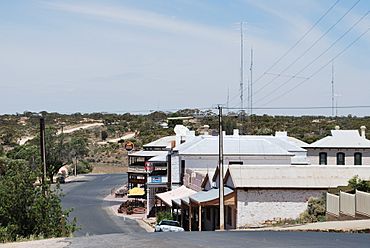Morgan, South Australia facts for kids
Quick facts for kids MorganSouth Australia |
|||||||||||||||
|---|---|---|---|---|---|---|---|---|---|---|---|---|---|---|---|
 |
|||||||||||||||
| Established | 25 April 1878 (town) 27 March 2003 (locality) |
||||||||||||||
| Postcode(s) | 5320 | ||||||||||||||
| Location | |||||||||||||||
| LGA(s) | Mid Murray Council | ||||||||||||||
| State electorate(s) | Chaffey | ||||||||||||||
| Federal Division(s) | Barker | ||||||||||||||
|
|||||||||||||||
| Footnotes | Adjoining localities | ||||||||||||||
Morgan is a town in South Australia. It sits on the right bank of the Murray River. This is where the river changes direction, from flowing west to flowing south. Morgan is about 161 kilometres (100 mi) northeast of Adelaide. It's also about 315 kilometres (196 mi) upstream from the Murray Mouth, where the river meets the sea.
History of Morgan
The land around Morgan has been home to Indigenous people for a very long time. Some of the original names for this area include Korkoranna for Morgan itself. Koolpoola was the name for the flats on the other side of the river. Coerabko, meaning "meeting place," was used for the river bend. Morgan is part of the traditional lands of the Ngaiawang people. Nganguruku people also moved to the Morgan area after losing access to their own lands further south.
The first Europeans to visit Morgan came by boat in 1830. This was the expedition led by Charles Sturt. Later, in March 1838, John Hill and his team explored the area on horseback. They noticed a large number of Indigenous people living there. Europeans first called this place the North West Bend. This was because the Murray makes a sharp turn here, changing from flowing west to flowing south. A large farm, Northwest Bend Station, was started in the 1840s and still has that name today.
The town of Morgan was officially created in 1878. It was named after Sir William Morgan. He was a very important politician at the time, serving as Chief Secretary and later as Premier of South Australia. In the same year, a railway line from Adelaide opened, connecting to Morgan.
A large wharf (a platform built out over the water for boats) was constructed. Morgan became one of the busiest ports on the Murray River. It was the end of the railway line, which is why a local hotel is called the Terminus Hotel. The port handled almost all the goods coming in and out of a huge area upstream along the Murray and Darling rivers. This included a lot of wool. At its busiest, Morgan was the second busiest port in South Australia, after Port Adelaide. Six trains a day carried goods from the Murray River to the sea at Port Adelaide.
As road transport improved in the early 1900s, river transport became less important. The railway to Morgan finally closed in 1969.
Historic Buildings
Morgan has many old buildings that are important to its history. These are called heritage-listed buildings. They help us remember what the town was like in the past.
Some of these special buildings include:
- Railway Terrace: The old railway station and the Station Master's House.
- 11 Railway Terrace: A row of buildings called Post Office Row.
- 25 Railway Terrace: A building known as Landseer's Store.
- The Morgan Wharf, which was once a very busy port.
Morgan Today
Today, Morgan is known for its many houseboat moorings and services. A houseboat marina (a special dock for boats) is being built. There is also a free ferry service that carries cars across the river 24 hours a day. Just south of Morgan is a riverfront area called Brenda Park. It started as simple shacks after World War II, but now has fancy holiday homes right on the water.
Even with these new changes, many historic buildings are still in town. Some of them have signs explaining what they used to be. The two historic hotels face each other across from the river. There is also a caravan park near the river. Morgan is part of the Mid Murray Council local government area. It is in the state electoral district of Stuart and the federal Division of Barker.
During World War II, a very important water pipe was built. This was the Morgan-Whyalla pipeline. It carried fresh water from the Murray River at Morgan all the way to the city of Whyalla.
A type of wasp, Pseudofoenus morganensis Jennings & Austin 2002, is named after the town of Morgan.
Gallery
See also
 In Spanish: Morgan (ciudad) para niños
In Spanish: Morgan (ciudad) para niños











